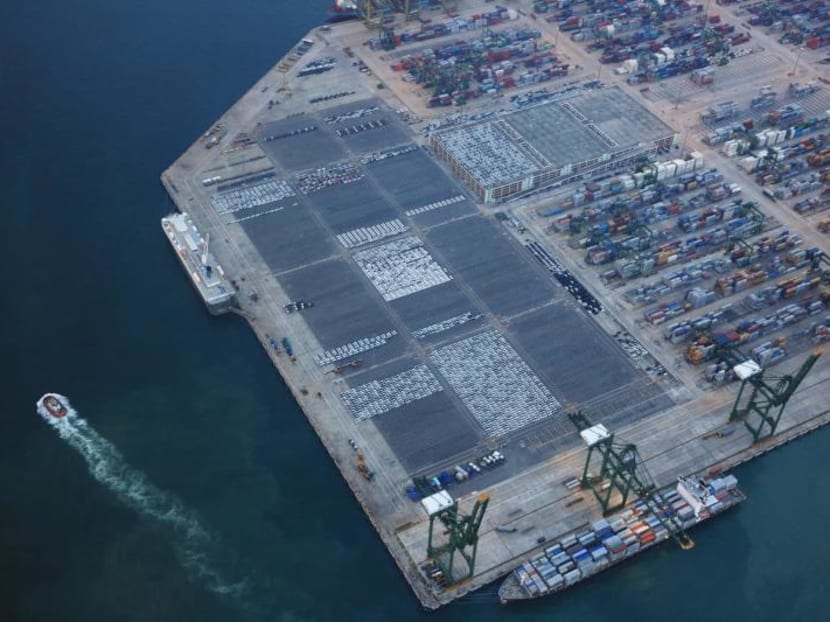Singapore’s trade sinks in June with record drop in electronics exports
SINGAPORE — Non-oil exports from Singapore sank to a six-year low — shrinking by 17.3 per cent year on year in June — as a weak global economy continues to pummel electronics shipments as it also plunged by record levels last month, new data from Enterprise Singapore showed on Wednesday (July 17).

Non-oil domestic exports in the first six months fell by 10.9 per cent year on year in 2019, compared with 20.3 per cent in 2009, which was during the global financial crisis.
SINGAPORE — Non-oil exports from Singapore sank to a six-year low — shrinking by 17.3 per cent year on year in June — as a weak global economy continues to pummel electronics shipments as it also plunged by record levels last month, new data from Enterprise Singapore showed on Wednesday (July 17).
Electronics exports declined by 31.9 per cent in June compared with the same period last year, extending the 31.6 per cent decrease in the previous month. This was the steepest drop in the exports of electronics since 1997 — before that, no such data was available.
Non-electronics exports, too, continued to suffer a slump in June, shrinking by 12.4 per cent year on year following the 11.1 per cent slide in May.
WORST FIRST HALF OF YEAR IN A DECADE, POOR OUTLOOK AHEAD
The underwhelming June trade performance wraps up the worst first-half result since the first half of 2009, economists said. Non-oil domestic exports in this period fell by 10.9 per cent year on year in 2019, compared with 20.3 per cent in 2009, which was during the global financial crisis.
The trade data follows advance estimates of a 0.1 per cent year-on-year gross domestic product growth for April to June, which was Singapore’s worst quarterly performance in a decade, the Ministry of Trade and Industry’s (MTI) data on Friday (July 12) showed.
Officially, MTI expects the economy to grow between 1.5 per cent and 2.5 per cent in 2019, though the state is reviewing the forecast as the trade war hits investments, trade and manufacturing, Monetary Authority of Singapore chief Ravi Menon said.
On Tuesday, the International Monetary Fund (IMF) downgraded Singapore’s growth forecast for 2019 from 2.3 per cent to 2 per cent. Several Singapore banks have followed suit, lowering their expectations for the year ahead and fuelling talk of a technical recession in the third quarter of 2019.
DBS Bank senior economist Irvin Seah said the persistence and the extent of non-oil domestic exports decline in recent months “is looking increasingly more like the period prior to the global financial crisis”. A near term recovery amid the hostile economic conditions also appears unlikely, said Mr Seah, adding: “Indeed, it’s that familiar sinking feeling again.”
Mr Joseph Incalcaterra, HSBC Global Research’s chief economist for the Association of South-east Asian Nations, said: “Even with some data stabilisation in the third quarter, it is clear that growth this year is slowing.”
He expects the MAS to ease its monetary policy at its next meeting in October by reducing the slope of the policy band which determines how the Singdollar can move.
ELECTRONICS SECTOR
Exports from the electronics manufacturing sector, which contributes nearly a third of Singapore’s overall manufacturing output and employs around 89,000 people, or 3 per cent of the country’s total workforce, has been hit hard by a weak external economy.
Singapore’s latest electronics Purchasing Managers’ Index, a key barometer of factory activity, remained in contraction territory with new orders falling to a three-year low last month.
Trade promotion agency Enterprise Singapore said the sector was dragged down the most by three segments on a year-on-year basis in June.
Exports of personal computers contracted the most by 44.6 per cent.
Disk media products, such as the hard drives and other types of electronic storage parts, saw 41.7 per cent less exports.
Integrated circuitry exports slid by 33 per cent. These are circuit boards that are found in electronic devices.
Re-exports of electronics also fell by 2.3 per cent in June, compared with a rise of 5.6 per cent in May. Overall non-oil re-exports, which is an indication of the health of the wholesale trade sector, shrank by 2.8 per cent last month.
WHAT ANALYSTS SAY
Analysts tell TODAY that the downward cycle in semiconductor demand, the simmering Sino-America trade tensions and a slowdown of China’s economy were among the many factors that have led to the sector's steep decline.
Mr Incalcaterra said the decline in electronics was “more or less” expected given the fall in electronic chip prices. Key memory chip prices, for example, are down approximately 60 per cent year on year in June, he said.
Besides the United States-China trade war, Mr Seah said the latest trade spat between Japan and Korea in the supply of electronics materials “has further added salt to wound”.
Tokyo and Seoul entered their own trade war on Monday, with the former taking its cue from the US to restrict exports of materials needed by the latter’s high-tech industry due to national security concerns.
Noting that trade tensions between the US and the Eurozone could be next, Mr Seah said: “There is no lack of risk in such a challenging economic climate.”
Describing the decline of electronics in June as a “nosedive”, Maybank Kim Eng economists Dr Chua Hak Bin and Ms Lee Ju Ye said it is in line with the weakening manufacturing sector in Singapore, noting that advance estimates show that industrial production had fallen sharply from -2.4 per cent in May to -8.7 per cent in June.
“Hopes for a recovery in electronics exports are dim as supply disruptions will likely worsen with US export controls on China and Japan’s export controls on South Korea,” they said.
With these factors dragging on Singapore’s external trade and industrial production, UOB economist Barnabas Gan said non-oil domestic exports could contract by 6 per cent in the whole year — the worst since the -7.2 per cent recorded in 2013.
“Given the weakness seen in June, we do expect further softness in export growth into the second half of 2019 should trade headwinds persist.”
ONLY IMPROVEMENT WAS AMERICAN EXPORTS
Exports to all the top markets, except the US, fell in June, said Enterprise Singapore. This was mainly due to a decline in non-oil domestic exports to Hong Kong, China and the Eurozone. Only the US saw exports pick up by 1.5 per cent year on year last month.
Hong Kong exports shrank by 38.2 per cent in June, compared with a contraction of 25.7 per cent in May. China exports also shrank by 15.8 per cent, Eurozone by 22.1 per cent, Taiwan by 28.3 per cent and Japan by 23.2 per cent. Exports to emerging markets, such as Latin America and the Middle East region, also fell overall by 17 per cent last month.
OCBC bank’s head of treasury research and strategy Selena Ling noted that exports to the US saw its fifth consecutive month of expansion.
“This appears to suggest that non-oil domestic exports to the US market remain the sole man standing at this juncture, barring further developments on the US-China trade front,” she said.
But overnight threats, such as US President Donald Trump threatening China with more tariffs “if we want” on Wednesday, could make things worse.
Dr Chua and Ms Lee said Singapore exports of tariffed products to both the US and China have been contracting, indicating that Singapore did not benefit from being on the sidelines of the US-China trade war.
While some commentators had previously suggested that Singapore could gain from a shift of the global value chains to the region, the Maybank economists said Vietnam is the biggest beneficiary from trade diversion due to US tariffs on China, while Malaysia is the main beneficiary from China tariffs on US products.








